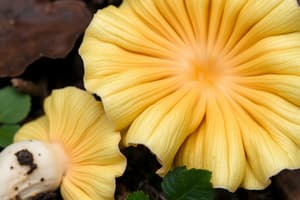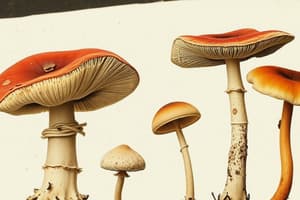Podcast
Questions and Answers
Which of the following mushrooms is known for its immune system support and antiviral properties?
Which of the following mushrooms is known for its immune system support and antiviral properties?
- Reishi mushroom
- Shiitake mushroom (correct)
- Button mushroom
- Chaga mushroom
Turkey tail mushroom is only used for cancer treatment and prevention.
Turkey tail mushroom is only used for cancer treatment and prevention.
False (B)
What are the three factors that affect the growth of mushrooms during cultivation?
What are the three factors that affect the growth of mushrooms during cultivation?
Temperature, humidity, and light
Oyster mushroom is a type of mushroom that is commonly ______________ during cultivation.
Oyster mushroom is a type of mushroom that is commonly ______________ during cultivation.
Match the following mushrooms with their respective medicinal uses:
Match the following mushrooms with their respective medicinal uses:
What is a characteristic used for mushroom identification?
What is a characteristic used for mushroom identification?
Morel mushroom is a type of edible species that can be eaten without any caution.
Morel mushroom is a type of edible species that can be eaten without any caution.
What is the name of the mushroom that can cause vomiting and diarrhea due to its toxin?
What is the name of the mushroom that can cause vomiting and diarrhea due to its toxin?
The ____________________ mushroom is a type of edible species that can be used in cooking.
The ____________________ mushroom is a type of edible species that can be used in cooking.
Match the following mushroom species with their characteristics:
Match the following mushroom species with their characteristics:
Flashcards are hidden until you start studying
Study Notes
Identification
- Characteristics used for identification:
- Cap shape, size, and color
- Gills or pores underneath the cap
- Stem shape, size, and color
- Ring or annulus on the stem
- Spore print color
- Tools used for identification:
- Hand lens or magnifying glass
- Field guides or identification keys
- Online resources and mushroom identification apps
Edible Species
- Common edible species:
- Button mushroom (Agaricus bisporus)
- Crimini mushroom (Criminus craterellus)
- Portobello mushroom (Agaricus bisporus)
- Shiitake mushroom (Lentinula edodes)
- Oyster mushroom (Pleurotus ostreatus)
- Edible species with caution:
- Chanterelle mushroom (Cantharellus cibarius) - can cause gastrointestinal upset in some individuals
- Morel mushroom (Morchella spp.) - can cause allergic reactions in some individuals
Poisonous Species
- Deadly poisonous species:
- Death cap mushroom (Amanita phalloides)
- Destroying angel mushroom (Amanita virosa)
- Poisonous species with severe symptoms:
- False morel mushroom (Gyromitra esculenta) - contains a toxin that can cause vomiting and diarrhea
- Conocybe filaris mushroom - contains a toxin that can cause vomiting, diarrhea, and abdominal pain
- Lookalike species:
- Some poisonous species can be mistaken for edible species (e.g., Destroying angel mushroom vs. Button mushroom)
Medicinal Uses
- Immune system support:
- Reishi mushroom (Ganoderma lucidum) - stimulates immune system and reduces inflammation
- Shiitake mushroom (Lentinula edodes) - stimulates immune system and has antiviral properties
- Antioxidant and anti-inflammatory properties:
- Chaga mushroom (Inonotus obliquus) - high in antioxidants and has anti-inflammatory properties
- Turkey tail mushroom (Trametes versicolor) - has antioxidant and anti-inflammatory properties
- Potential health benefits:
- Cancer treatment and prevention
- Cardiovascular health
- Anti-aging and cognitive function
Cultivation
- Methods of cultivation:
- Indoor cultivation using substrate (e.g., straw or compost)
- Outdoor cultivation using logs or stumps
- Factors affecting growth:
- Temperature
- Humidity
- Light
- Nutrient availability
- Commonly cultivated species:
- Oyster mushroom (Pleurotus ostreatus)
- Shiitake mushroom (Lentinula edodes)
- Button mushroom (Agaricus bisporus)
Identification
- Cap shape, size, and color are key characteristics for identification
- Gills or pores underneath the cap are important identification features
- Stem shape, size, and color, as well as the presence of a ring or annulus, aid in identification
- Spore print color is a crucial factor in identifying mushroom species
- Hand lenses or magnifying glasses help examine small features
- Field guides, identification keys, and online resources are essential tools for identification
Edible Species
- Button mushroom (Agaricus bisporus) is a common edible species
- Crimini mushroom (Criminus craterellus) is another common edible species
- Portobello mushroom (Agaricus bisporus) is a popular edible species
- Shiitake mushroom (Lentinula edodes) and oyster mushroom (Pleurotus ostreatus) are also edible
- Chanterelle mushroom (Cantharellus cibarius) and morel mushroom (Morchella spp.) require caution due to potential gastrointestinal upset or allergic reactions in some individuals
Poisonous Species
- Death cap mushroom (Amanita phalloides) and destroying angel mushroom (Amanita virosa) are deadly poisonous species
- False morel mushroom (Gyromitra esculenta) contains a toxin that causes vomiting and diarrhea
- Conocybe filaris mushroom contains a toxin that causes vomiting, diarrhea, and abdominal pain
- Some poisonous species are easily mistaken for edible species, such as destroying angel mushroom vs. button mushroom
Medicinal Uses
- Reishi mushroom (Ganoderma lucidum) stimulates the immune system and reduces inflammation
- Shiitake mushroom (Lentinula edodes) stimulates the immune system and has antiviral properties
- Chaga mushroom (Inonotus obliquus) has high antioxidant levels and anti-inflammatory properties
- Turkey tail mushroom (Trametes versicolor) has antioxidant and anti-inflammatory properties
- Medicinal mushrooms may have potential health benefits, including cancer treatment and prevention, cardiovascular health, and anti-aging and cognitive function
Cultivation
- Indoor cultivation uses substrates like straw or compost, while outdoor cultivation uses logs or stumps
- Temperature, humidity, light, and nutrient availability affect mushroom growth
- Oyster mushroom (Pleurotus ostreatus), shiitake mushroom (Lentinula edodes), and button mushroom (Agaricus bisporus) are commonly cultivated species
Studying That Suits You
Use AI to generate personalized quizzes and flashcards to suit your learning preferences.




